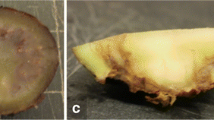Summary
The formation of fertile crosses (when possible), nuclear DNA relatedness and sequence comparison of select region of a large subunit (25S) ribosomal RNA are suitable methods for taxonomic determination and a phylogenetic classification of the strains. These genetic methods can also be used to predict whichFusarium strains produce mycotoxins since the genetic placement of the strains has been shown to have a good correlation with mycotoxin production ability at the species level.
Similar content being viewed by others
References
Booth C (1971) The genusFusarium. Commonwealth Mycological Institute, Kew, Surrey England.
Marasas WFO, Nelson PE, Toussoun TA (1984) ToxigenicFusarium species: Identity and Mycotoxicology. Pennsylvania State University Press. University Park
Thrane U (1989)Fusarium species and their specific profiles of secondary metabolites. In J Chelkowski (ed.),Fusarium Mycotoxins, Taxonomy and Pathogenicity. Elsevier Sci Pub BV; 199–225
Glyn AN, and Reid J (1969) Electrophoretic patterns of soluble fungal proteins and their possible use as taxonomic criteria in the genusFusarium. Can J Bot 47:1823–1831
Partridge JE, Nelson PE, and Toussoun TA (1984) Ribosomal proteins of the genusFusarium. Mycologia 76:533–544
Scala F, Cristizio G, Marziano F, and Noviello C (1981) Endopolygalacturonase zymograms ofFusarium species. Trans Br Mycol Soc 77:587–591
Kurtzman CP, Smiley MJ, Robnett CJ, and Wicklow DT (1986) DNA relatedness among wild and domesticated species in theAspergillus favus group. Mycologia 78:955–959
Kuhlman EG (1982) Varieties ofGibberella fujikuroi with anamorphs inFusarium sectionLiseola. Mycologia 74:759–768.
Ellis JJ (1988) SectionLiseola ofFusarium. Mycologia 80:225–258
Desjardins AE and Beremand M (1987) A genetic system for trichothecene toxin production inGibberella pulicaris (Fusarium sambucinum). Phytopathology 77:678–683
Guadet J, Julien J, Lafay J-F, and Brygoo Y (1989) Phylogeny of someFusarium species determined by large-subunit rRNA sequence comparison. Mol Biol Evol 6:227–242.
Desjardins AE and Plattner RD (1989) Trichothecene toxin production by strains ofGibberella pulicaris (Fusarium sambucinum) in liquid culture and in potato tubers. J Agric Food Chem 37:387–392.
Ellis JJ (1989) An alignment of toxigenicGibberella strains having anamorphs in the sectionLiseola ofFusarium. Mycologia 81:307–311.
Logrieco A, Peterson SW, Mulè G, and Bottalico A (1990) Molecular genetic criteria for the identification of atypicalFusarium strain. In: Abstract of Papers of 4th international Mycological Congress, Regensburg, Germany, 28th August–3rd September 1990, Section poster ID-199/1, 199.
Vesonder RF, Logrieco A, Peterson SW, and Bottalico A (1990) Reexamination of the taxonomic disposition of and deoxynivalenol production byMicrodochium nivale (Fusarium nivale) NRRL 3289. In Abstracts of Papers of Second European Seminar “Fusarium -Mycotoxins, Taxonomy, Pathogenicity”; Poznan, Poland, 5–7 September 1990, 11.
Author information
Authors and Affiliations
Rights and permissions
About this article
Cite this article
Logrieco, A., Bottalico, A. & Mulè, G. Genetic analysis as a tool for prediction of mycotoxin-producing Fusarium strains. Mycotox Res 7 (Suppl 1), 38–42 (1991). https://doi.org/10.1007/BF03192182
Issue Date:
DOI: https://doi.org/10.1007/BF03192182




